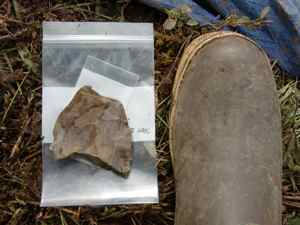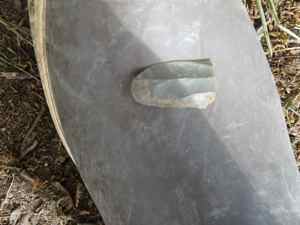At the risk of using an archaeological pun, it's time to write a bit about what we're doing here. I mean really, what's the point of spending 8 or 9 hours a day carefully troweling down through layers of dirt in a hole in the ground? What happens to all those bits of chert that we find when we sift the dirt or the bigger chunks that we mark so carefully when we find them in our sections? What can you learn from a handful of rock chips that may only be slightly larger than 1/8" across?
I am learning that archaeology involves creating stories from the smallest of clues. Creating those stories requires careful attention to detail and thinking about all the possible connections between seemingly unrelated objects or activities. For example, imagine that you are magically transported 12,000 years into the future. You are wandering around in this future world, and suddenly come upon a plastic tine from a fork. Then you look around a bit more and find a small bit of thin plastic. A more thorough search might reveal even more bits of plastic in a variety of colors and shapes. While you know nothing about the people who left this plastic, you might know that plastic was a product that was in use until perhaps 10,000 years ago. You might also know a bit about specific types of plastic and how they were used. If you wanted to learn more about this 'Plastic Man' you might choose to dig in that area to see what other sorts of artifacts you could find that might help you piece together the story. You might even want to do a bit of research to see what sorts of plastic artifacts had been found in other parts of the world. Little by little you would create a story about the culture of Plastic People' and how they lived.
That's not that different from what we are doing here at Raven's Bluff. In this case, the clues we are finding are bits of chert and bone. The chert pieces, called flakes, are left when someone (or a group of people) sat around making stone tools. Perhaps they were making tools or just sharpening or refining tools that they made elsewhere. Either way, small bits of stone are left on the ground. The bone bits are left behind after killing or eating animals.
The stone and bone bits will be cleaned, cataloged, and examined in a laboratory after the summer field season. What can you learn from these pieces? Stones can be chemically analyzed and compared with samples from known sites to determine where they came from? Were they from local stone or from far away? The size and shape of the flakes can help you figure out what stages of tool making were conducted here or what sorts of tools they were making. If you know what kinds of tools they were using you can make some guesses about how they were using those tools. The bone bits will be analyzed to determine what animals they were from. You can also figure out what part of the animal they came from and a bit about how they were killed or prepared by looking at markings on the bones. Little by little, all these clues turn into a story--kind of like making a story web when you're planning a large essay.

Another focus of the project is the stone points that have been found in past seasons. The points are a style known as a fluted point and resemble the Clovis points found in areas in the continental United States. These Clovis points are considered to be the oldest points found in the United States. While there are older artifacts found in Alaska, this site is the first place that Clovis-style points have been found. The points have been dated and are younger than 12,000 years old. Now the story gets a bit more interesting. Did people come across the Bering Land Bridge and bring their technology south? Did another group of people travel north and bring their technology with them? How and why does technology travel between groups of people? The work we are doing may help answer some of these questions and provide another 'chapter' in the story.

The weather today seemed to change at least every hour, going from grey and misty to sunny and breezy and everything in-between. The breeze kept the mosquitoes down to a tolerable level for most of the day. Of course, while we are working, I need to take a few breaks to scan the horizon for wildlife and take in the outrageous scenic beauty. This morning I saw over 300 caribou grazing far across the river to the east of our camp. At one point there was a little 'Wild Kingdom' moment, when a grizzly sow and cub were chasing the herd. The chase went unrewarded, at least as far as I could see through my binoculars. There was also another bear to the northwest of our dig. While these sightings have been far away and visible mostly with binoculars, it's a good reminder of who actually lives here!
And--if you did your homework assignment from yesterday, here's the answer to yesterday's math question--141.5cm is the length of the diagonal for our 1-meter square study areas.


Comments